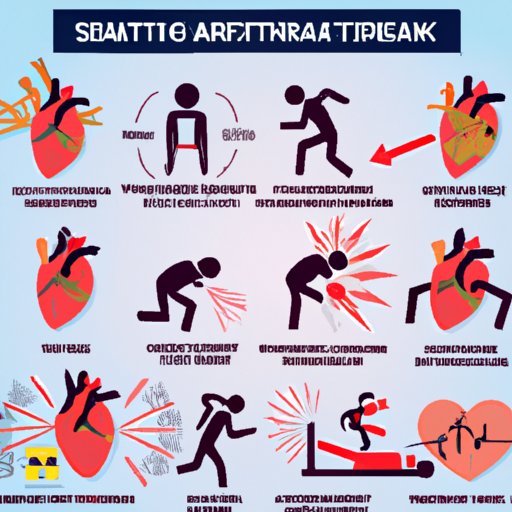
I. Introduction
Your heart is one of the hardest working organs in your body, pumping blood to every part of your body. A heart attack occurs when the blood flow to a part of the heart is blocked or reduced, leading to severe consequences. In the United States, heart disease is the leading cause of death for both men and women, causing one in four deaths each year. It is crucial to understand the signs and symptoms of a heart attack and act quickly. In this article, we will explore what happens when a heart attack occurs, what to do in case of an emergency, how to rebuild your health after a heart attack, and lifestyle changes to reduce the risk of another heart attack.
II. The Silent Killer: Understanding the Signs and Symptoms of a Heart Attack
A heart attack occurs when there is a blockage in the blood vessels that supply blood to the heart. The blockage is often due to a buildup of plaque made of cholesterol, calcium, and other substances in the arteries, reducing blood flow to the heart. The longer the blood flow is blocked, the more heart muscle dies. It is essential to know the signs and symptoms of a heart attack so that you can get treatment as soon as possible.
The signs and symptoms of a heart attack can vary widely, both in type and intensity. Some people experience intense chest pain, while others experience mild discomfort or no chest pain at all. Other common signs and symptoms include:
- Shortness of breath
- Nausea or vomiting
- Pain or discomfort in the arms, jaw, neck, or back
- Sweating
- Lightheadedness
If you or someone you know experiences any of these symptoms, call 911 immediately. Acting fast is crucial in determining the outcome of a heart attack.
III. Acting Fast: How to Respond When Someone is Having a Heart Attack
If someone experiences the signs and symptoms of a heart attack, it is essential to act fast. Here are some crucial steps you should take in case of a heart attack emergency:
- Call 911 immediately. If you are with someone who is experiencing a heart attack, do not drive to a hospital. An ambulance will provide faster and more effective medical care.
- Help the person take aspirin, if recommended by their doctor.
- If the person becomes unconscious, perform cardiopulmonary resuscitation (CPR). If you do not know how to do CPR, 911 operators can guide you through the procedure over the phone.
IV. Recovering After a Heart Attack: A Guide to Rebuilding Your Health
After a heart attack, your doctor will recommend a treatment plan based on your condition. Common treatments include medications to prevent blood clots, reduce blood pressure, and control cholesterol levels. Additional procedures may include angioplasty or bypass surgery, where the blocked arteries are reopened or replaced to restore blood flow.
Rebuilding your health after a heart attack is essential to prevent future heart attacks and live a healthy life. Lifestyle changes such as developing a healthy diet and exercise plan, quitting smoking, and reducing stress can dramatically improve your health and reduce the risk of another heart attack.
Your doctor may suggest participating in a cardiac rehabilitation program, which is a supervised exercise and education program that helps you recover from a heart attack and improve your overall health. Studies have shown that cardiac rehabilitation programs can reduce the risk of death and hospitalization and improve the quality of life for people who have had a heart attack.
V. Prevention is Key: Lifestyle Changes to Reduce Your Risk of Heart Attack
Prevention is key to reducing the risk of a heart attack and living a long, healthy life. Several lifestyle changes can be made to reduce your risk of heart attack:
- Quit smoking
- Exercise regularly
- Adopt a heart-healthy diet, including plenty of fruits, vegetables, and whole grains while limiting saturated fats and added sugars.
- Manage stress through relaxation techniques such as deep breathing, meditation, or yoga.
- Control blood pressure and cholesterol levels through medication and lifestyle changes.
VI. Heart Attack Misconceptions: Common Myths and Facts You Should Know
There are many misconceptions about heart attacks, such as the belief that only older people or men are at risk. However, heart attacks can occur at any age and affect people of all genders. Other common myths and facts to know include:
- Myth: Heart attacks only happen to people with a family history of heart disease.
- Fact: Although family history plays a role, lifestyle factors such as smoking, poor diet, physical inactivity, and stress can significantly increase the risk of heart attack.
- Myth: Women do not experience the same symptoms as men during a heart attack.
- Fact: While chest pain is the most common symptom of a heart attack, women may experience less typical symptoms, such as shortness of breath, back pain, or nausea.
- Myth: Only overweight or obese people are at risk of a heart attack.
- Fact: People of all weights and body types can have a heart attack. However, excess body weight puts extra strain on the heart.
VII. Conclusion
A heart attack is a life-threatening medical emergency that requires prompt medical attention. Understanding the signs and symptoms of a heart attack, knowing what to do in case of an emergency, and taking steps to prevent future heart attacks can significantly reduce your risk and improve your overall health. Remember to always act fast when experiencing the signs and symptoms of a heart attack, and seek immediate medical attention to reduce the risk of severe health consequences.




